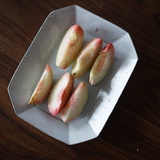在项目当中我们总会遇到这样的页面:页面顶部是一个表单筛选项,下面是一个表格展示数据。表格下方是一个分页器,这样的页面在我们的后台管理系统中经常所遇到,有时候可能不止一个页面,好几个页面的结构都是这种。如图:

本人记得,在react中的高级组件库中有这么一个组件,就实现了这么一个效果。就拿这个页面来说我们实现一下组件封装的思想:1.首先把每个页面的公共部分抽出来,比如标题等,用props或者插槽的形式传入到组件中进行展示 2. 可以里面数据的双向绑定实现跟新的效果 3. 设置自定义函数传递给父组件要做上面事情
1.将公共的部分抽离出来
TableContainer组件<template> <div>这里的话利用了具名插槽插入了navbar、table组件,title通过props的属性传入到子组件当中。进行展示,
父组件 <TableContainer title="资源审核"> <template v-slot:navbar> <my-affix :offset="0"> <Navbar/> </my-affix> </template> <template v-slot:table> <SourceAuditTable/> </template> </TableContainer>当然这是一个非常非常简单的组件封装案例
接下来我们看一个高级一点的组件封装
父组件
<template> <div> <hr> <HelloWorld :page.sync="page" :limit.sync="limit" /> </div></template><script>import HelloWorld from './components/HelloWorld.vue';export default { data() { return { page: 1, limit: 5 } }, components: { HelloWorld },}</script>父组件传递给子组件各种必要的属性:total(总共多少条数据)、page(当前多少页)、limit(每页多少条数据)、pageSizes(选择每页大小数组)
子组件
<template> <el-pagination :current-page.sync="currentPage" :page-size.sync="pageSize" :total="20" /></template><script>export default { name: 'HelloWorld', props: { page: { default: 1 }, limit: { default: 5 }, }, computed: { currentPage: { get() { return this.page }, set(val) { //currentPage 这里对currentPage做出来改变就会走这里 //这边更新数据走这里 console.log('currentPage', this.currentPage) this.$emit('update:page', val) } }, pageSize: { get() { return this.limit }, set(val) { this.$emit('update:limit', val) } } }, methods: { }}</script><!-- Add "scoped" attribute to limit CSS to this component only -->这里的page.sync、limit.sync目的就是为了实现数据的双向绑定,computed中监听page和limit的变化,子组件接收的数据通过computed生成的currentPage通过sync绑定到了 el-pagination中, 点击分页器的时候会改变currentPage 此时会调用set函数设置新的值,通过代码 this.$emit(update:page,value) 更新父组件中的值,实现双向的数据绑定
作者:安静的搬砖人链接:https://juejin.cn/post/7312353213347708940
